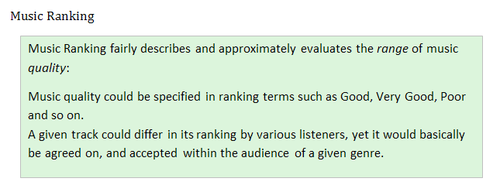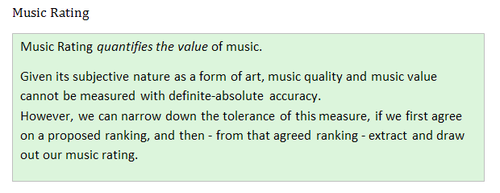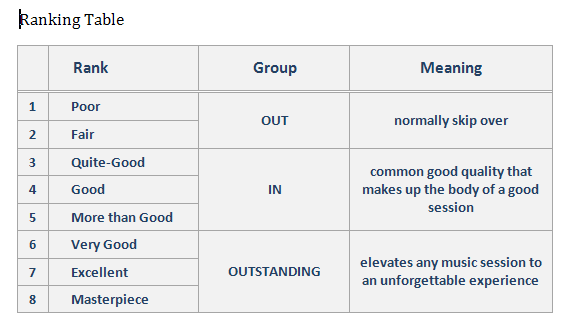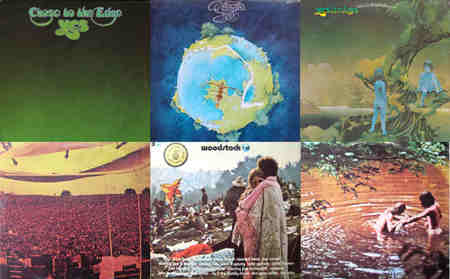The purpose of this article is to show you how to rate music, and tell you what it takes for a system to do exactly just that.
If we could have placed our music on a measurable scale, and tagged it by its quality, it would have then proved to be very helpful in making better music selections and managing large collections of music.
The secret key, the path to make the right music selections when spontaneous is lost, is to place all our music on one accepted measuring scale, a solid base line from which we could compare, categorize, and organize music to match our preferences with greater ease.
1. False consensus over music ratings
“Why should I rate music? Music is here to enjoy, not to rate”.
Yes, this is a good an a hard question that even the serious minded music lovers would question themselves, debate over it and doubt it.
Our choices of music are today almost unlimited with type, style, genre and performers. How else can we practically concentrate on our music likings, focus the choices towards our own preferences and make better selections of music?
There is a false-consensus over the use of music ratings that unnecessarily denies the so many benefits to listeners.
This is a good opportunity to explain why it is perfectly “safe” and healthy to practice music ratings.
Our main purpose in using music ratings is to make better music selections.
A good rating system can help us to better organize-categorize-compare and classify music, and help us discover new recordings by relating to their value.
There are many more things that these ratings could do for us.
We will cover them here.
2. Ranking vs. Rating
Music is a form of art that connects to the mind and soul.
It’s about feeling, touching, moving, sensing it, connecting to relevant events and times, having fun with, engaging, and everything that makes up a relationship that we human define as love.
Because of all that complexity, we can only value music by asking how much we love it, how good was it as an experience, and how much would it make us want to repeat that experience over and over - again and again.
Let’s dive in and begin with two really important definitions, and then get straight to our point of how to rate music.
2A. Music Ranking

2B. Music Rating

Since we are not yet at the age of measuring feelings, we got to trust our inner guts, and express the total experience in relative terms - we have to at first rank music, and then try to express that in terms of rating.
For practical sake, ranking music - tracks or songs, give us a pretty good idea over the quality of any given music. If we can refer to a song by a rank that says ‘Poor’ or ‘Very Good’ or ‘Master Piece’, that is a description that can tell us what to expect.
Ratings are a better way to express the quality of albums (not tracks) because of differences in time lengths.
A ‘Good’ album that runs for 38 minutes does not have the same value compared to another ‘Good’ album that runs for 78 minutes…
Therefore, we say that those two albums are similar in quality, they are both ‘Good’ albums, but the 78 minute has higher value for maintaining that quality over a longer period of time than the 38 minute album.
If you like the idea of rating music over time length, you can check out more on that down at the bottom of this article, where we introduce the first True music rating service, ever.
Our first step is therefore to rank music on a relative scale.
Then we can convert each rank by a determined set of values, to a scoring number that sets our music rating.
3. How to rank music?
With all said, here is a suggested ranking scale of 8 ranks that cover the spectrum of possibilities for any given music.
This is the same ranking table that is used by the allmusicrating rating system.
For sake of conveyance these eight ranks are placed in three groups:
1 OUT - the very low ranked music that we normally skip over, on a regular playing session.
2 IN - the mainstream common good quality ranked music that makes up the body of a good session.
3 OUTSTANDING - top ranked music that elevates any music session to an unforgettable experience.
And these are the 8 ranks: 
4. Beyond Music Ratings
Let’s now discuss the principles of ranking and rating music, how we should approach this, and take a quick look at what are the main considerations.
I won’t get into the obvious environment issues such as surroundings, sound system, the timing and whatever keeps you at your highest mood for a good music session.
These are all self-explanatory and personal considerations that should be determined individually by the listener.
Here are the important points that one has to keep in mind while listening and ranking music:
a) Acquaintance
You have to be acquainted with the music you are about to rank and rate.
Acquaintance is very individual and subject to the complexity of the music, and to the experience of the listener.
b) Context
Music has to be ranked by its own appeal, and also by the full context, meaning that we should ask ourselves how much we like it, how it connected with the other tracks, how it maintained the flow within the album, and how much did it shine compared to the other pieces.
There is a big difference between ranking individual music tracks by themselves, alone, and by ranking them within the complete original album.
The complete album is home to that music, it’s where it belongs, where they connect, fit into a theme and groove in a flow of the complete piece of art.
“Together we stand, divided we fall”…
c) Music consistency
Certain tracks are difficult to rate.
Some of the reasons that make it hard to rank and rate music could be: changes in the mood of the music within itself, changes in its power, melody, tempo, because of complexity, or perhaps because the music was just too long and had many ups and downs.
Whatever reasons of uncertainty are there, the way to go by is to consider its overall quality, trying to average the “highs” and “lows” and mainly by comparing that track to other tracks on the album – see next point.
d) Relativity
Music could also be ranked and rated in comparison.
That’s when you use the relative judgment by comparing that unknown ranking track to something else, preferably of the same artist, and within the same album.
e) Complexity
Consider complexity of music.
Smaller tracks (in length) that sound great at first hearings tend to loose attractiveness within time as they “burn out” on us.
And the opposite is the case with longer and complex music where early listening may not expose their potential, but after few hearings they begin to sink in and open up.
When you attempt to rank complex music, make sure that you do that only after you got very well acquainted with it, whatever amount of sessions and hearings would it take.
f) Wear off
There is a life span to our excitement for any given music.
What it means is that music, does ‘wear off’ and lose attraction after too many listening’s in a burn out rate that usually relates to its complexity.
Complex music could in fact gain more appreciation over time, where common popular music fades and makes place for new comers.
g) Early releases
Early releases are quite often the very special and the best output of most artists.
They capture sounds and spirits that would never repeat again for that given growing musician.
Sounds of youth.
Sounds of fresh and raw material, aggressive, eager, furious, brave and yet naive artists that just want their art to make a difference, and make that change in this world.
These early recordings are the fruit of ideas, and work that had all the time in the world to develop, up to that point in life when they finally break out.
The fame and pressure that follows the early success typically take their toll on the artist and kill much of that creativity that made them to the top.
And so, most musicians are only famous for accounting just few of their albums that carry on their legend for many years.
Typically, their best music is what they had released in their first few years of professional music creation.
Sure, some – but not too many of these musicians are fortunate to develop, build up on talent and creativity, and expand their music and career.
Pay special attention to the early releases of your favorite artist.
They are usually worth much more than what you have thought.
h) Lyrics and music
Lyrics and music connect like body and soul.
Lyrics have much more significance than the meaning of their words.
Those words may not always connect and make sense, but they serve music in so many other ways.
Lyrics carry the music.
They give music power, motion, beat, and life.
Lyrics may lift up the music, move it around, lower it softly, roll it, shake it, give it a dimension of life and a beat, and frame up the music into sections.
Lyrics make up the body of music.
And while lyrics are so significant in the structure of some of the major musical works, it is the music itself, the melody that shapes and make music what it is; king of popular art.
Without music-melody the words turn to poems.
Some of the greatest genres are all about pure music, such as Classical music and great portions of Jazz music. And then, some music is all about the lyrics, where the artist turns over the conventional structure and uses the lyrics as the body and the soul of their work, leaving the melody as only secondary.
A good example for this is ‘Imagine’ by John Lennon.
The melody is really simple and almost unnoticeable, but then comes in the lyrics that turn it into a masterpiece.
An even better example is the music of Leonard Cohen who was very minimal on melody, and based most of his music on verbal content.
i) Music artwork
Music artwork, or as we see it in the design of vinyl and cd packages has a role in delivering a certain experience.
The artwork serves as an eye catcher - a glimpse to the musical adventure that’s hidden within the album, inside that package.
And when impressively done, it can transform our mind into that music.
A good example of impressing artwork is in the early albums of Yes (it’s the name of a progressive band…).
Another example of remarkable artwork that practically shifts the mind into the musical scene is the original triple sleeve for the audio soundtrack of Woodstock.
Check out these artwork examples in the following images.
Music artwork that inspires the experience.

These are all important considerations that influence our ruling, and when we know about them, and when we are aware to their role, we can then make better judgments and end up with solid ratings.
5. How to turn your music session into a blast?
You begin with your music set to a nice decent volume.
Loud music is not a crime.
Concert halls, theaters, cinemas, they all have their systems cranked up for a good reason.
I keep my volume high and loud leaving just a little room for an “extra mile” for highlights that develop deep into the session.
At any given setup, surrounding, environment and set conditions, the one and most important factor that determines the quality of your music session, above anything else, is the music content itself -
what you have chosen to be played.
Your perfect selection would answer as many of the following questions:
If its relevant, if it’s authentic, if its timed well, if it fits into the mood, if it’s been a while, since you’ve heard it, if it has been missed – and if you have made the right selection.
There is no formula to this magic of a perfect music session, but music ratings are your best friends in selecting relevant music that would strike on the moment, and get you closer to your perfect music session.
We human are normally tempted to repeat what has already worked well for us, and what we feel comfortable with, and so we naturally go for the obvious safe big hits;
we go for albums that are milestones in music, and we go with the top artists and their best work.
Repeating this habit, this framework of a ‘natural’ choice is boring, is repetitive, is overused, and it’s a lazy habit that leaves us with another ‘OK’ session, nothing special, and nothing great.
Few choices are easy to handle…
Concentrating repeatedly on the best music that represents just a portion of a typical collection does not hold in the long run.
More choices mean more variety and excitement.
But when we are given almost unlimited choices – we then have a problem figuring out what’s best for that moment.
At this point music ratings can help us tremendously.
We can use ratings to ‘dig-in deeper’ into music and screen out what’s not relevant.
Music ratings are not just a key component, but THE factor that makes or break music sessions.
I got tons of music in my collection but I simply just cannot remember them all.
Who can?
Music ratings are the map to music content.
You then see the big picture.
It gives you more options to work out different paths into music exploration.
There are all of those “other” albums; the unfamiliar albums that you have no clue what’s hidden inside them; that you have no idea how and where to find their hidden treasures.
Music ratings give you access to so much of more music that otherwise you would never get to explore.
And a great portion of that undiscovered music is already in your collection, but it’s hidden in dust; or maybe hidden in a lost digital track that’s buried down thousands of other.
It will simply help you manage your music efficiently and give you better answers as to:
What to play, when, and how to arrange the order of your selections.
6. This is how I manage my physical music collection
I have a rating card attached and inserted into every single album in my collection.
It maps my music by individual tracks, and by complete albums.
These ratings tell me the essence of every track, every album, the highlights, the main body of my music content, and it helps me manage my music sessions, every time I listen to music.
The common thought today is that it is almost sinful to “listen” to a rating system that would interfere in our judgment and in our own human feelings.
But the truth is that music ratings express our feelings and our judgment over music.
When we rank a given track as a ‘Good” track, we only document that as a rating, for our convenience.
It is not only safe to adopt ratings into our listening habits, but in today’s reality of massive music content, it gives us an easy choice to screen out the noise and focus on “our” relevant music.
You can try this groundbreaking and free new music service at allmusicrating.com
It is about to change your whole preception and approach over music exploration.
For the love of music.
Nissim Elias
About the author:
Nissim Elias, is the creator of the first True Music Rating System called EARs© at allmusicrating.com
Allmusicrating (2017) is an application and a database that measures the quality of music over their Time Length, based on users ranking.
The system provides True music ratings© of individual tracks, complete albums, artists, and music of all genres.
~ Quantifying Music Quality to appreciate Music Value ~